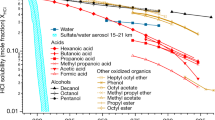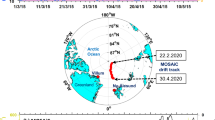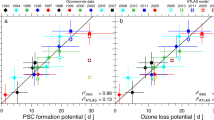Abstract
The abundance of chlorine in the Earth’s atmosphere increased considerably during the 1970s to 1990s, following large emissions of anthropogenic long-lived chlorine-containing source gases, notably the chlorofluorocarbons. The chemical inertness of chlorofluorocarbons allows their transport and mixing throughout the troposphere on a global scale1, before they reach the stratosphere where they release chlorine atoms that cause ozone depletion2. The large ozone loss over Antarctica3 was the key observation that stimulated the definition and signing in 1987 of the Montreal Protocol, an international treaty establishing a schedule to reduce the production of the major chlorine- and bromine-containing halocarbons. Owing to its implementation, the near-surface total chlorine concentration showed a maximum in 1993, followed by a decrease of half a per cent to one per cent per year4, in line with expectations. Remote-sensing data have revealed a peak in stratospheric chlorine after 19965, then a decrease of close to one per cent per year6,7, in agreement with the surface observations of the chlorine source gases and model calculations7. Here we present ground-based and satellite data that show a recent and significant increase, at the 2σ level, in hydrogen chloride (HCl), the main stratospheric chlorine reservoir, starting around 2007 in the lower stratosphere of the Northern Hemisphere, in contrast with the ongoing monotonic decrease of near-surface source gases. Using model simulations, we attribute this trend anomaly to a slowdown in the Northern Hemisphere atmospheric circulation, occurring over several consecutive years, transporting more aged air to the lower stratosphere, and characterized by a larger relative conversion of source gases to HCl. This short-term dynamical variability will also affect other stratospheric tracers and needs to be accounted for when studying the evolution of the stratospheric ozone layer.
This is a preview of subscription content, access via your institution
Access options
Subscribe to this journal
Receive 51 print issues and online access
$199.00 per year
only $3.90 per issue
Buy this article
- Purchase on Springer Link
- Instant access to full article PDF
Prices may be subject to local taxes which are calculated during checkout




Similar content being viewed by others
References
Lovelock, J. E., Maggs, R. J. & Wade, R. J. Halogenated hydrocarbons in and over the Atlantic. Nature 241, 194–196 (1973)
Molina, M. J. & Rowland, F. S. Stratospheric sink for chlorofluoromethanes: chlorine atom-catalysed destruction of ozone. Nature 249, 810–812 (1974)
Farman, J. C., Gardiner, B. G. & Shanklin, J. D. Large losses of total ozone in Antarctica reveal seasonal ClOx/NOx interaction. Nature 315, 207–210 (1985)
World Meteorological Organization Scientific Assessment of Ozone Depletion: 2010 (Report 52, Global Ozone Research and Monitoring Project, WMO, 2011); http://www.wmo.int/pages/prog/arep/gaw/ozone_2010/ozone_asst_report.html
Rinsland, C. P. et al. Long-term trends of inorganic chlorine from ground-based infrared solar spectra: past increases and evidence for stabilization. J. Geophys. Res. 108 (D8), 27, http://dx.doi.org/10.1029/2002JD003001 (2003)
Froidevaux, L. et al. Temporal decrease in upper atmospheric chlorine. Geophys. Res. Lett. 33, http://dx.doi.org/10.1029/2006GL027600 (2006)
Kohlhepp, R. et al. Observed and simulated time evolution of HCl, ClONO2, and HF total column abundances. Atmos. Chem. Phys. 12, 3527–3556 (2012)
Zander, R. et al. The 1985 chlorine and fluorine inventories in the stratosphere based on ATMOS observations at 30° north latitudes. J. Atmos. Chem. 15, 171–186 (1992)
Nassar, R. et al. A global inventory of stratospheric chlorine in 2004. J. Geophys. Res. 111 D22312 http://dx.doi.org/10.1029/2006JD007073 (2006)
Gardiner, T. et al. Trend analysis of greenhouse gases over Europe measured by a network of ground-based remote FTIR instruments. Atmos. Chem. Phys. 8, 6719–6727 (2008)
Froidevaux, L. et al. GOZCARDS Merged Data for Hydrogen Chloride Monthly Zonal Means on a Geodetic Latitude and Pressure Grid version 1.01, http://dx.doi.org/10.5067/MEASURES/GOZCARDS/DATA3002 (NASA Goddard Earth Science Data and Information Services Center, accessed, June 2013)
Russell, J. M., III et al. The halogen occultation experiment. J. Geophys. Res. 98, 10777–10797 (1993)
Bernath, P. F. et al. Atmospheric Chemistry Experiment (ACE): mission overview. Geophys. Res. Lett. 32, L15S01, http://dx.doi.org/10.1029/2005GL022386 (2005)
Waters, J. W. et al. The Earth Observing System Microwave Limb Sounder (EOS MLS) on the Aura satellite. IEEE Trans. Geosci. Rem. Sens. 44, 1075–1092 (2006)
Laube, J. C. et al. Newly detected ozone-depleting substances in the atmosphere. Nature Geosci. 7, 266–269 (2014)
Dee, D. P. et al. The ERA-Interim reanalysis: configuration and performance of the data assimilation system. Q. J. R. Meteorol. Soc. 137, 553–597 (2011)
Waugh, D. W., Strahan, S. E. & Newman, P. A. Sensitivity of stratospheric inorganic chlorine to differences in transport. Atmos. Chem. Phys. 7, 4935–4941 (2007)
Engel, A. et al. Age of stratospheric air unchanged within uncertainties over the past 30 years. Nature Geosci. 2, 28–31 (2009)
McLandress, C. & Shepherd, T. G. Simulated anthropogenic changes in the Brewer-Dobson circulation, including its extension to high latitude. J. Clim. 22, 1516–1540 (2009)
Stiller, G. P. et al. Observed temporal evolution of global mean age of stratospheric air for the 2002 to 2010 period. Atmos. Chem. Phys. 12, 3311–3331 (2012)
Rothman, L. S. et al. The HITRAN 2008 molecular spectroscopic database. J. Quant. Spec. Radiat. Transf. 110, 533–572 (2009)
Acknowledgements
The University of Liège contribution was mainly supported by the Belgian Science Policy Office (BELSPO) and the Fonds de la Recherche Scientifique–FNRS, both in Brussels. Additional support was provided by MeteoSwiss (Global Atmospheric Watch) and the Fédération Wallonie–Bruxelles. We thank the International Foundation High Altitude Research Stations Jungfraujoch and Gornergrat (HFSJG, Bern). We thank O. Flock and D. Zander (University of Liège). The SLIMCAT modelling work was supported by the UK Natural Environment Research Council (NCAS and NCEO). The FTIR measurements at Ny-Ålesund, Spitsbergen, are supported by the AWI Bremerhaven. The work from Hampton University was partially funded under the NASA MEASURE’s GOZCARDS programme and the National Oceanic and Atmospheric Administration’s Educational Partnership Program Cooperative Remote Sensing Science and Technology Center (NOAA EPP CREST). The ACE mission is supported primarily by the Canadian Space Agency. We thank U. Raffalski and P. Voelger for technical support at IRF Kiruna. The National Center for Atmospheric Research is supported by the National Science Foundation. The observation programme at Thule, Greenland, is supported under contract by the National Aeronautics and Space Administration (NASA) and the site is also supported by the NSF Office of Polar Programs. We thank the Danish Meteorological Institute for support at Thule. Work at the Jet Propulsion Laboratory, California Institute of Technology, was performed under contract with NASA; we thank R. Fuller for help in producing the GOZCARDS data set, and work by many ACE-FTS, HALOE and MLS team members who helped to produce data towards the GOZCARDS data set is also acknowledged. We thank O. E. García, E. Sepúlveda, and the State Meteorological Agency (AEMET) of Spain for scientific and technical support at Izana. The Australian Research Council has provided notable support over the years for the NDACC site at Wollongong, most recently as part of project DP110101948. Measurements at Lauder are core funded through New Zealand’s Ministry of Business, Innovation and Employment. We are grateful to all colleagues who have contributed to FTIR data acquisition. We thank ECMWF for providing the ERA-Interim reanalyses.
Author information
Authors and Affiliations
Contributions
M.P., J.W.H., F.H., E.M., I. Murata, N.B.J., C.P.-W. and D.S. performed the Ny-Ålesund, Thule, Kiruna and Izana, Jungfraujoch, Tsukuba, Wollongong and Lauder retrievals for HCl, respectively. P.F.B. and K.A.W. provided ACE-FTS data; L.F. and J.A. provided the GOZCARDS data set. J.A., P.F.B., L.F., J.M.R. III and K.A.W. provided expertise on satellite data usage. M.P.C., R.H., S.S.D. and W.F. designed and performed the SLIMCAT runs, sensitivity analyses and transport diagnostics. T.R. performed the KASIMA model run and corresponding diagnostics. B.F. and E.M. performed the trend analyses and compiled the results. J.N., M.T.C., T.B., C.S., I. Morino, H.N., M.S., D.W.T.G. and D.S. are responsible for the instrumentation and data acquisition at the NDACC stations. E.M. initiated and coordinated the study. The figures were prepared by E.M. and B.F. (Fig. 1), E.M. (Fig. 2), R.H. and M.P.C. (Fig. 3) and T.R. (Fig. 4). E.M., M.P.C. and J.N. wrote the manuscript. Together with T.R., they revised it and included the comments from the co-authors.
Corresponding author
Ethics declarations
Competing interests
The authors declare no competing financial interests.
Additional information
NDACC data are publicly available at ftp://ftp.cpc.ncep.noaa.gov/ndacc/station/ and GOZCARDS data are publicly available at http://measures.gsfc.nasa.gov/opendap/GOZCARDS/.
Extended data figures and tables
Extended Data Figure 1 Evolution of HCl in the Earth’s atmosphere and comparison with KASIMA model results.
a, The long-term total column time series of HCl at Jungfraujoch (running average with a 3-yr integration length, step of 1 month; in red, left scale, in molecules per cm2) and the global total tropospheric chlorine volume mixing ratio (blue curve, right scale). Lower panels display the running average total column time series (1997–2011) of HCl at Ny-Ålesund (b), Jungfraujoch (c) and Lauder (d), derived from the NDACC–FTIR observations and from the KASIMA run (grey). The thin red lines correspond to the ±2 standard error of the mean range. The vertical dashed lines identify the occurrence of the minimum total columns at the Northern Hemisphere sites, in July 2007.
Extended Data Figure 2 HCl relative rates of change at eight NDACC sites.
a and b provide the rates of change (per cent per year) for the 1997–2007 (1999–2007 for Thule and Izana, 1998–2007 for Tsukuba) and 2007–2011 time periods, respectively. They were derived from the FTIR and GOZCARDS observational data sets and from the SLIMCAT and KASIMA simulated time series (see colour key). The error bars correspond to the 2σ level of uncertainty.
Extended Data Figure 3 Evolution of stratospheric HCl from satellite observations.
Comparison of merged GOZCARDS satellite HCl observations (by HALOE, ACE-FTS and Aura/MLS) with KASIMA model results for Northern and Southern Hemisphere mid-latitude lower (46 hPa) and upper (7 hPa) stratosphere. GOZCARDS monthly mean observations are shown as red dots. Linear fits to the GOZCARDS data and the KASIMA run are displayed as red and blue lines, respectively, for periods before and after 2005. An upward trend is observed and modelled in the Northern Hemisphere lower stratosphere (d) while HCl is decreasing in the southern and northern upper stratosphere (a, b); volume mixing ratio in parts per billion.
Extended Data Figure 4 Spatial distribution of the HCl concentration and age-of-air changes.
Mean differences of the HCl concentration (a) and age-of-air (b) between 2010/11 and 2005/06, as a function of altitude and latitude, derived from the KASIMA model simulation. c, Running averages of the mean age-of-air at 50 hPa (thick/thin curve, integration length of 36/6 months), at the same sites as in Fig. 1 (time series at 79° N/45° S have been shifted vertically by −0.75/−0.50 yr). Comparison with age-of-air time series derived from SLIMCAT (see Fig. 4c) indicates that KASIMA provides higher absolute values of mean age-of-air. Note that the upper boundary of KASIMA is at 120 km, yielding higher mean ages, compared to SLIMCAT (upper boundary 60 km).
Rights and permissions
About this article
Cite this article
Mahieu, E., Chipperfield, M., Notholt, J. et al. Recent Northern Hemisphere stratospheric HCl increase due to atmospheric circulation changes. Nature 515, 104–107 (2014). https://doi.org/10.1038/nature13857
Received:
Accepted:
Published:
Issue Date:
DOI: https://doi.org/10.1038/nature13857
This article is cited by
-
Multi-decadal variability controls short-term stratospheric water vapor trends
Communications Earth & Environment (2023)
-
Renewed and emerging concerns over the production and emission of ozone-depleting substances
Nature Reviews Earth & Environment (2020)
-
A statistical analysis of time trends in atmospheric ethane
Climatic Change (2020)
-
How to determine the complex refractive index from infrared reflectance spectroscopy?
SN Applied Sciences (2020)
-
Room-temperature heterodyne terahertz detection with quantum-level sensitivity
Nature Astronomy (2019)
Comments
By submitting a comment you agree to abide by our Terms and Community Guidelines. If you find something abusive or that does not comply with our terms or guidelines please flag it as inappropriate.



